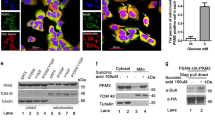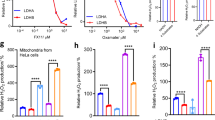Abstract
The NADPH oxidase (NOX) is a significant determinant for the expression and activity of γ-glutamyltransferase (GGT), which is frequently upregulated after increased levels of reactive oxygen species (ROS) and oxidative stress. Earlier studies on human colon carcinoma HT-29 cells have shown that treatment with phorbol 12-myristate 13-acetate (PMA) activates NOX thus increasing the intracellular level of ROS and upregulating GGT. Another important source of cellular ROS is the mitochondria, and treatment with the mitochondria uncoupler carbonylcyanide-4-(trifluoromethoxy)-phenylhydrazone (FCCP) results in increased ROS levels. The present study shows that when HT-29 cells were simultaneously treated with both agents, a significant and synergic increase in intracellular ROS was detected. NOX activity contributed at least 50 % of this increase as inhibiting NOX activity with apocynin or downregulating the NOX activity using siRNA against p22 phox reduced the synergic ROS production. The combined FCCP and PMA treatment also provoked highly increased GGT mRNA levels after 24 h whereas only minor and delayed increases in GGT protein and enzyme activity levels were detected. The results strongly indicate that ROS production by both mitochondria and NOX is involved in the regulation of GGT expression in colon carcinoma cells.




Similar content being viewed by others
References
Block K, Gorin Y (2012) Aiding and abetting roles of NOX oxidases in cellular transformation. Nat Rev Cancer 12:627–637. doi:10.1038/nrc3339
Mitsushita J, Lambeth JD, Kamata T (2004) The superoxide-generating oxidase Nox1 is functionally required for Ras oncogene transformation. Cancer Res 64:3580–3585. doi:10.1158/0008-5472.CAN-03-3909
Ralph SJ, Rodriguez-Enriquez S, Neuzil J, Saavedra E, Moreno-Sanchez R (2010) The causes of cancer revisited: “mitochondrial malignancy” and ROS-induced oncogenic transformation—why mitochondria are targets for cancer therapy. Mol Aspects Med 31:145–170. doi:10.1016/j.mam.2010.02.008
Daiber A (2010) Redox signaling (cross-talk) from and to mitochondria involves mitochondrial pores and reactive oxygen species. Biochim Biophys Acta 1797:897–906. doi:10.1016/j.bbabio.2010.01.032
Kamata T (2009) Roles of Nox1 and other Nox isoforms in cancer development. Cancer Sci 100:1382–1388. doi:10.1111/j.1349-7006.2009.01207.x
Lambeth JD (2004) NOX enzymes and the biology of reactive oxygen. Nat Rev Immunol 4:181–189. doi:10.1038/nri1312
Aykin-Burns N, Ahmad IM, Zhu Y, Oberley LW, Spitz DR (2009) Increased levels of superoxide and H2O2 mediate the differential susceptibility of cancer cells versus normal cells to glucose deprivation. Biochem J 418:29–37. doi:10.1042/BJ20081258
Coso S, Harrison I, Harrison CB, Vinh A, Sobey CG, Drummond GR, Williams ED, Selemidis S (2012) NADPH oxidases as regulators of tumor angiogenesis: current and emerging concepts. Antioxid Redox Signal 16:1229–1247. doi:10.1089/ars2011.4489
Kumar B, Koul S, Khandrika L, Meacham RB, Koul HK (2008) Oxidative stress is inherent in prostate cancer cells and is required for aggressive phenotype. Cancer Res 68:1777–1785. doi:10.1158/0008-5472.CAN-07-5259
Kajla S, Mondol AS, Nagasawa A, Zhang Y, Kato M, Matsuno K, Yabe-Nishimura C, Kamata T (2012) A crucial role for Nox 1 in redox-dependent regulation of Wnt-beta-catenin signaling. FASEB J 26:2049–2059. doi:10.1096/fj.11-196360
Lu W, Hu Y, Chen G, Chen Z, Zhang H, Wang F, Feng L, Pelicano H, Wang H, Keating MJ, Liu J, McKeehan W, Luo Y, Huang P (2012) Novel role of NOX in supporting aerobic glycolysis in cancer cells with mitochondrial dysfunction and as a potential target for cancer therapy. PLoS Biol 10:e1001326. doi:10.1371/journal.pbio.1001326
Dikalov S (2011) Cross talk between mitochondria and NADPH oxidases. Free Radic Biol Med 51:1289–1301. doi:10.1016/j.freeradbiomed.2011.06.033
Forman HJ, Zhang H, Rinna A (2009) Glutathione: overview of its protective roles, measurement, and biosynthesis. Mol Aspects Med 30:1–12. doi:10.1016/j.mam.2008.08.006
Franco R, Cidlowski JA (2009) Apoptosis and glutathione: beyond an antioxidant. Cell Death Differ 16:1303–1314. doi:10.1038/cdd.2009.107
Hanigan MH, Ricketts WA (1993) Extracellular glutathione is a source of cysteine for cells that express gamma-glutamyl transpeptidase. Biochemistry 32:6302–6306
Obrador E, Carretero J, Ortega A, Medina I, Rodilla V, Pellicer JA, Estrela JM (2002) gamma-Glutamyl transpeptidase overexpression increases metastatic growth of B16 melanoma cells in the mouse liver. Hepatology 35:74–81. doi:10.1053/jhep.2002.30277
Ravuri C, Svineng G, Pankiv S, Huseby NE (2011) Endogenous production of reactive oxygen species by the NADPH oxidase complexes is a determinant of gamma-glutamyltransferase expression. Free Radic Res 45:600–610. doi:10.3109/10715762.2011.564164
Ravuri C, Svineng G, Huseby NE (2013) Differential regulation of gamma-glutamyltransferase and glutamate cysteine ligase expression after mitochondrial uncoupling: gamma-glutamyltransferase is regulated in an Nrf2- and NFkappaB-independent manner. Free Radic Res 47:394–403. doi:10.3109/10715762.2013.781270
Livak KJ, Schmittgen TD (2001) Analysis of relative gene expression data using real-time quantitative PCR and the 2(−Delta Delta C(T)) Method. Methods 25:402–408. doi:10.1006/meth2001.1262
Ravuri C, Svineng G, Huseby NE (2013) Differential regulation of gamma-glutamyltransferase and glutamate cysteine ligase expression after mitochondrial uncoupling: gamma-glutamyltransferase is regulated in an Nrf2- and NFkappaB-independent manner. Free Radic Res. doi:10.3109/10715762.2013.781270
Schulz E, Wenzel P, Munzel T, Daiber A (2012) Mitochondrial redox signaling: interaction of mitochondrial reactive oxygen species with other sources of oxidative stress. Antioxid Redox Signal. doi:10.1089/ars.2012.4609
Wosniak J Jr, Santos CX, Kowaltowski AJ, Laurindo FR (2009) Cross-talk between mitochondria and NADPH oxidase: effects of mild mitochondrial dysfunction on angiotensin II-mediated increase in Nox isoform expression and activity in vascular smooth muscle cells. Antioxid Redox Signal 11:1265–1278. doi:10.1089/ars.2009.2392
Desouki MM, Kulawiec M, Bansal S, Das GM, Singh KK (2005) Cross talk between mitochondria and superoxide generating NADPH oxidase in breast and ovarian tumors. Cancer Biol Ther 4:1367–1373
Lee SB, Bae IH, Bae YS, Um HD (2006) Link between mitochondria and NADPH oxidase 1 isozyme for the sustained production of reactive oxygen species and cell death. J Biol Chem 281:36228–36235. doi:10.1074/jbc.M606702200
Rathore R, Zheng YM, Niu CF, Liu QH, Korde A, Ho YS, Wang YX (2008) Hypoxia activates NADPH oxidase to increase [ROS]i and [Ca2 +]i through the mitochondrial ROS-PKCepsilon signaling axis in pulmonary artery smooth muscle cells. Free Radic Biol Med 45:1223–1231. doi:10.1016/j.freeradbiomed.2008.06.012
Graham NA, Tahmasian M, Kohli B, Komisopoulou E, Zhu M, Vivanco I, Teitell MA, Wu H, Ribas A, Lo RS, Mellinghoff IK, Mischel PS, Graeber TG (2012) Glucose deprivation activates a metabolic and signaling amplification loop leading to cell death. Mol Syst Biol 8:589. doi:10.1038/msb.2012.20
Nimnual AS, Taylor LJ, Bar-Sagi D (2003) Redox-dependent downregulation of Rho by Rac. Nat Cell Biol 5:236–241. doi:10.1038/ncb938
Hu Y, Lu W, Chen G, Wang P, Chen Z, Zhou Y, Ogasawara M, Trachootham D, Feng L, Pelicano H, Chiao PJ, Keating MJ, Garcia-Manero G, Huang P (2012) K-ras(G12V) transformation leads to mitochondrial dysfunction and a metabolic switch from oxidative phosphorylation to glycolysis. Cell Res 22:399–412. doi:10.1038/cr.2011.145
Trachootham D, Alexandre J, Huang P (2009) Targeting cancer cells by ROS-mediated mechanisms: a radical therapeutic approach? Nat Rev Drug Discov 8:579–591. doi:10.1038/nrd2803
Huseby NE, Asare N, Wetting S, Mikkelsen IM, Mortensen B, Sveinbjornsson B, Wellman M (2003) Nitric oxide exposure of CC531 rat colon carcinoma cells induces gamma-glutamyltransferase which may counteract glutathione depletion and cell death. Free Radic Res 37:99–107
Lieberman MW, Wiseman AL, Shi ZZ, Carter BZ, Barrios R, Ou CN, Chevez-Barrios P, Wang Y, Habib GM, Goodman JC, Huang SL, Lebovitz RM, Matzuk MM (1996) Growth retardation and cysteine deficiency in gamma-glutamyl transpeptidase-deficient mice. Proc Natl Acad Sci USA 93:7923–7926
Reuter S, Schnekenburger M, Cristofanon S, Buck I, Teiten MH, Daubeuf S, Eifes S, Dicato M, Aggarwal BB, Visvikis A, Diederich M (2009) Tumor necrosis factor alpha induces gamma-glutamyltransferase expression via nuclear factor-kappaB in cooperation with Sp1. Biochem Pharmacol 77:397–411. doi:10.1016/j.bcp.2008.09.041
West MB, Wickham S, Quinalty LM, Pavlovicz RE, Li C, Hanigan MH (2011) Autocatalytic cleavage of human gamma-glutamyl transpeptidase is highly dependent on N-glycosylation at asparagine 95. J Biol Chem 286:28876–28888. doi:10.1074/jbc.M111.248823
Visvikis A, Pawlak A, Accaoui MJ, Ichino K, Leh H, Guellaen G, Wellman M (2001) Structure of the 5′ sequences of the human gamma-glutamyltransferase gene. Eur J Biochem 268:317–325
Acknowledgments
This work was supported by The Norwegian Cancer Society, The Erna and Olav Aakre Foundation for Cancer Research and The Northern Norway Regional Health Authorities. We thank Roy Lyså at the Bio Imaging FUGE Core facility, Institute of Medical Biology, The Faculty of Health Sciences, for his assistance with the acquisition of the flow cytometry data.
Author information
Authors and Affiliations
Corresponding author
Rights and permissions
About this article
Cite this article
Pandur, S., Ravuri, C., Moens, U. et al. Combined incubation of colon carcinoma cells with phorbol ester and mitochondrial uncoupling agents results in synergic elevated reactive oxygen species levels and increased γ-glutamyltransferase expression. Mol Cell Biochem 388, 149–156 (2014). https://doi.org/10.1007/s11010-013-1906-1
Received:
Accepted:
Published:
Issue Date:
DOI: https://doi.org/10.1007/s11010-013-1906-1




